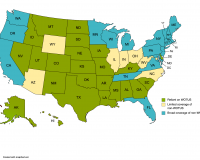
Vibrant Environment
Governance And Rule Of Law
All | Biodiversity | Climate Change and Sustainability | Environmental Justice | Governance and Rule of Law | Land Use and Natural Resources | Oceans and Coasts | Pollution Control

Yesterday morning, the U.S. Supreme Court heard oral argument in a pair of cases—Loper Bright Enterprises v. Raimondo and Relentless, Inc. v. Department of Commerce—that by all accounts have the potential to result in a seismic shift in administrative and regulatory law, including changes for courts, the President and federal agencies, Congress, and the public.

Starting with the January/February 2024 issue, the Environmental Forum has a change: “The,” capitalized and in italics, is no longer part of our name—too 20th century, to be frank. This change comes as a result of celebrating our 40th anniversary with this issue, a time for reflection as to the foundational purposes behind this publication and to honor the roster of leading professionals who have made it possible.

Household recycling can reduce demand for virgin materials, limit waste sent to landfills, and lessen the cost of producing metal-, glass-, and paper-containing products. Understanding the policies most conducive to promoting recycling is key to success. The November 2023 issue of ELR—The Environmental Law Reporter looks at the efficacy of state and local recycling policies and identifies contexts where the greatest improvements are possible. Using the most comprehensive data set on U.S. household recycling behavior, authors Joel Huber, W.

On May 25, the U.S. Supreme Court eliminated a major swath of CWA protections when it issued its decision in Sackett v. Environmental Protection Agency. In the Court’s view, the CWA extends to only those "wetlands with a continuous surface connection to bodies that are 'waters of the United States' in their own right," such that they are indistinguishable from those waters.

By formally recognizing the Right to a Clean, Healthy, and Sustainable Environment through two separate resolutions in 2022, the United Nations has set the stage for a more just and inclusive world. Big headlines like this often overlook all the background work necessary to make it happen. That’s what makes the 2023 UN Human Rights Prize incredibly exciting.

Fresh fish in Lincoln, Nebraska. Atlantic Salmon born and raised in America for an American market. Thriving aquatic ecosystems in the Mediterranean Sea, currently the world’s most overfished sea. Realizing these visions are trademark promises made by the land-based aquaculture (LBA) industry.

Water is life. All living things depend on water; human society depends on water. We need water for drinking, sanitation, food security, biodiversity, sustainable development—truly everything. Even though water is necessary for life, so many of us lack access to water. Water scarcity and water pollution are worsening, all while water demand is increasing.

The conference at Airlie House in September 1969 produced the Environmental Law Institute and Law and the Environment, a book of the papers presented at the meeting. Though published by one of ELI’s fiscal sponsors, it demonstrates that from its very beginning, ELI was at the forefront of environmental law. ELI and the American Law Institute began their collaboration educating attorneys about environmental law in 1970.

On May 25 the Supreme Court, ruling in Sackett v. EPA, sharply limited the scope of the federal Clean Water Act’s protection for the nation’s waters. The Court redefined the Act’s coverage of “waters of the United States” (WOTUS), which has been hotly contested since the Court’s previous 2006 decision in Rapanos v. United States.

In 1970, Pres. Richard Nixon issued Reorganization Plan No. 4, creating the National Oceanic Atmospheric Administration (NOAA), and Reorganization Plan No. 3, establishing the U.S. Environmental Protection Agency (EPA).